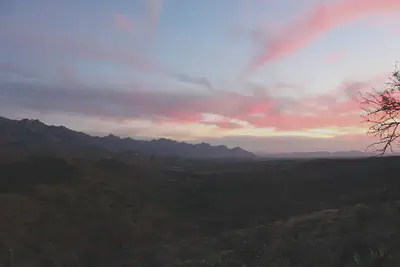Do tropical trees root deeply? A unique experiment on dynamics of tree water uptake at Biosphere 2
Or: Kathi’s final PhD paper and the process of making it
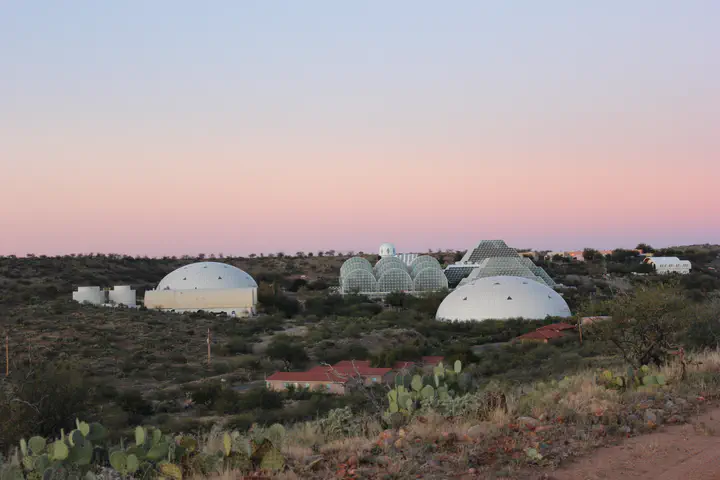
Back in 2019/2020 Isodrones were part of the big, interdisciplinary project B2 WALD (Water, Atmosphere and Life Dynamics) at an enclosed model tropical ecosystem at Biosphere 2, Arizona, USA. Isodrones PhD student Kathrin Kühnhammer rarely left this weird and wonderful place for three months. Now, she finally published the data she collected and reports on her experience and the publication’s outcomes in this blog post.
What is Biosphere 2?
The basic idea of Biosphere 2 is to mimic a small-scale earth in order to test if closed ecological systems could enable humans to live in outer space or a post-apocalyptic world. It is a building complex with lots of technical infrastructure and seven big green houses connecting different “biomes” of the world (tropical rainforest, ocean, mangrove wetlands, savannah grassland, fog desert, agricultural system and human habitat). Construction was finished in 1991 and in the following two years, eight “Biospherians” participated in the worlds longest closed ecosystem experiment.
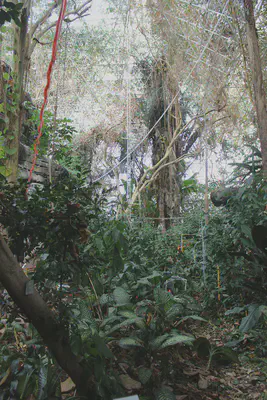
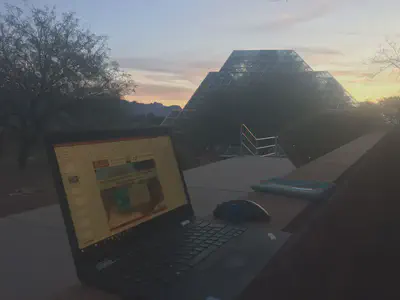
Since 2011, the University of Arizona is the owner of Biosphere 2 and uses it to conduct controlled ecosystem experiments like the B2 WALD project.
If you want to know more about Science taking place at Biosphere 2 including the B2 WALD experiment (minutes 4:26 – 6:10) check out the following video:
https://www.youtube.com/watch?v=l8ulXtBe658
If you want to find out more about the enclosure in the 90s, you might want to check out this article
https://www.theguardian.com/film/2020/jul/13/spaceship-earth-arizona-biosphere-2-lockdown
or listen to the TED talk by Jane Poynter, one of the original Biospherians
https://tammytourguide.wordpress.com/2020/04/09/biosphere-2-isolated-living-in-arizona/
My personal experience

Together with many other scientist I lived on the premises of Biosphere 2 in small bungalows called “casitas” and we spent most of our waking time inside the tropical rainforest fixing things, taking samples and making sure that we were producing usable data. We had one car that about 20 scientists shared and we took turns to get croceries at the next supermarket located about an hour away. With lots to do and too little time, we could have probably not survived without our quesadilla maker and after having quesadilla for almost every lunch for so many weeks, I think it will remind me of this experience for life. At night usually we had diner together and sometimes we drank a beer while watching the sunset or the pigs or the turkeys that were living there with us. If we felt adventurous we explored the labyrinth beneath the green houses containing millions of pipes, cables and pumps.
To be honest, this experiment was crazy and quite demanding both physically and mentally. Working almost every day, not a lot of sleep during busy times, living in the middle of nowhere with little distraction and fun activities around, being away from family and friends, feeling the pressure from limited time and unexpected obstacles, leaks in the in situ isotope system and below-ground drainage pipes causing sleepless nights… But also I met so many awesome, helpful and inspiring people during that time and often we felt like we were the next generation of Biospherians. The more pressure and workload we felt, the sillier we became and the more we supported each other. And I guess not many people in this world get to be inside Biosphere 2 at night when tourist masses are replaced by herds of cockroaches and everything becomes calm and mystical and sometimes also a bit creepy. Like the amazing sunsets over the Catalina mountain range, it is an experience I will not forget and I am grateful for all the things I learnt as a scientist and a human :D
Why study water uptake through deep roots?
Droughts are expected to occur more often and with higher intensity as a consequence of climate change. One important plant trait to buffer negative effects of droughts and increase resilience are deep roots because they provide access to deeper, often more reliable soil water sources. By this, deep roots have a great impact on ecosystem water cycling. But is this really important in environments, where water usually is not scarce? Current knowledge about rooting depth and how much deep roots contribute to plant water use under different conditions is fragmented and especially scarce in the humid tropics.
What did we do?
First, the whole ecosystem was exposed to a two-months drought, during which the trees clearly suffered. They lost leaves and strongly reduced their water uptake. At peak drought, we pumped 23.000 l of water marked with heavy hydrogen isotopologues into the bottom-most 5 cm of soil (in depths ranging from 1.4 to 3.3 m). In the following, we observed if and how trees used this water source. About a week later, the first rain event in weeks released the tropical forest from drought stress. Another week later normal rainfall restarted.
Throught the experiment (five months in total), we monitored water fluxes from soils, through trees and back into the atmosphere in 10 different tree individuals belonging to five tropical species. For this, we measured soil water content and potential in different depths. We used in situ methods to directly measure water stable isotopologues in soil and plant water in real time and obtain daily information on the contribution of deep vs shallow soil water to tree transpiration. We deployed sap flow sensors to find out, how much water was overall transported by individual trees from soils to the atmosphere. Tree water storage was investigated by installing TDR probes into tree trunks.
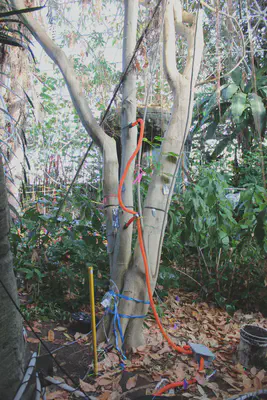
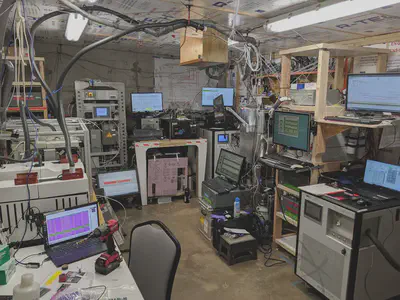
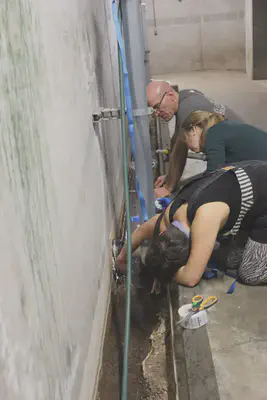
So how did the trees react?
All large canopy trees (eight out of ten!) took up deep soil water and this source made up a big proportion of water uptake during times when the surface soil was dry. However, trees reduced their total water uptake during drought conditions and increased it again, when precipitation added water to shallow soil. At the same time, trees switched their water uptake from deep to shallow soils. In other words, this means: on larger time scales total transpired water amount is greatly sourced from precipitation and shallow soil water. However, deep roots play an important role to help trees survive drought periods. Overall, water uptake amount, drought and re-wetting responses differed quite substantially between tree individuals. We found the differences in the plasticity and temporal dynamics of tree water storage especially interesting and think that this should be investigated further in future research.
Want to know more?
The paper is freely available for everyone!
https://www.sciencedirect.com/science/article/pii/S0048969723033867?via%3Dihub
Final personal thoughts on closed ecosystem experiments
Biosphere 2 provided a unique opportunity for us to control environmental conditions and expose a tropical rainforest to drought. Also, a comparable spatial labeling of deep soil water is simply not possible in a normal forest. However, this level of control comes at a prize. The “forest” was constructed by humans at the edge of the sonoran desert, which intrinsically makes it highly artificial. For this reason as well as because of its limited size it will never completely mimic a natural tropical forest. And as any ecosystem, species and plant individual is complex and slightly different, we have no choice but to conduct more research at different levels of control - in laboratories, closed and natural system - and compare the results to each other in order to uncover the principles of tree drought responses.
